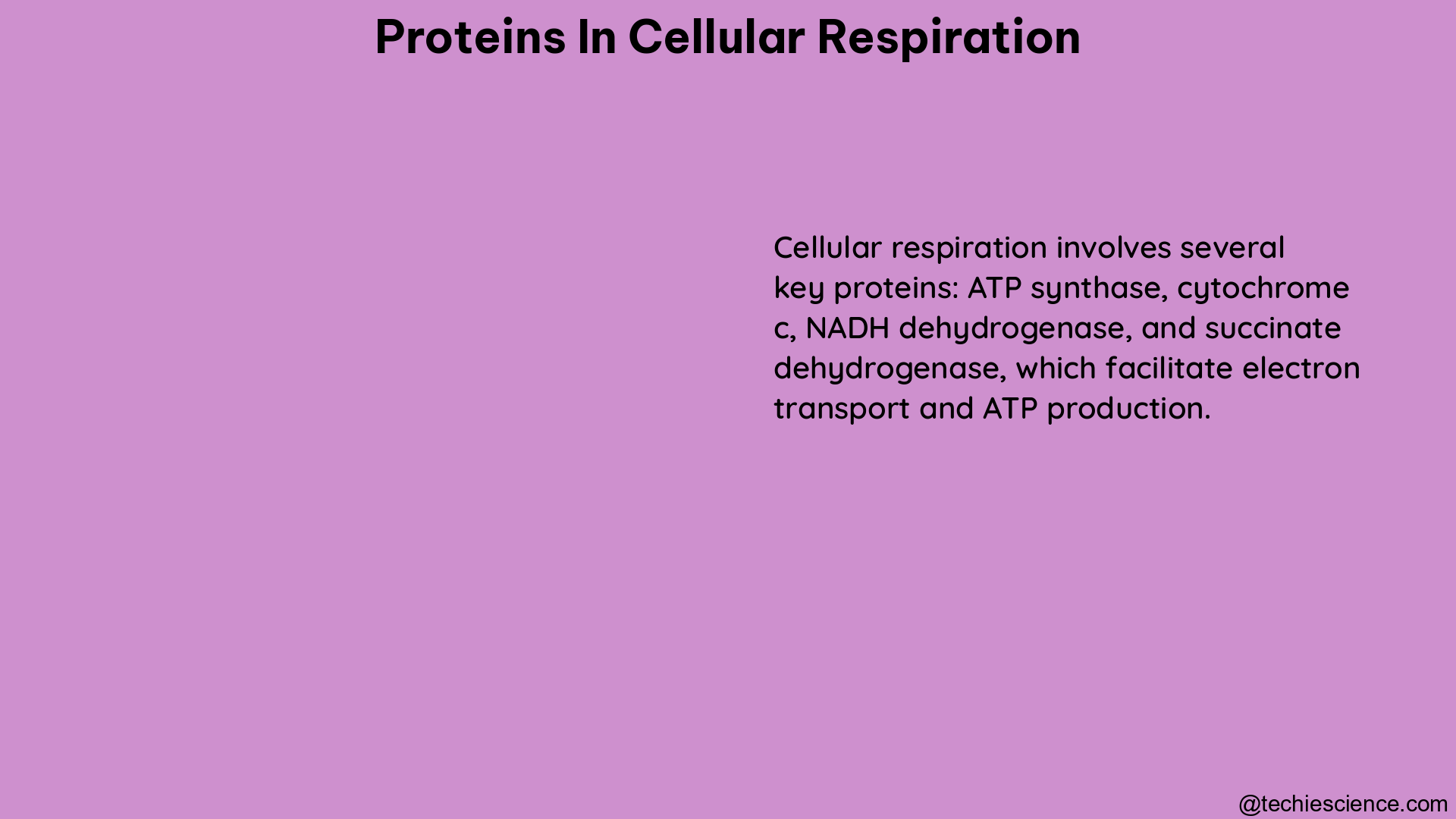Proteins play a pivotal role in the intricate process of cellular respiration, which is responsible for converting the chemical energy stored in glucose into a form that cells can readily utilize, known as ATP (Adenosine Triphosphate). This process involves three main stages: glycolysis, the Krebs cycle, and the electron transport chain, with proteins serving as essential catalysts and structural components at each step.
Glycolysis: The Protein-Powered Breakdown of Glucose
Glycolysis, the first stage of cellular respiration, occurs in the cytosol of the cell and involves the breakdown of glucose into two molecules of pyruvate, generating ATP and NADH (Nicotinamide Adenine Dinucleotide) in the process. Proteins, in the form of enzymes, are the driving force behind this stage, facilitating each step with remarkable precision.
- Hexokinase: This enzyme catalyzes the phosphorylation of glucose, converting it into glucose-6-phosphate, the first step in glycolysis.
- Phosphofructokinase: This enzyme catalyzes the phosphorylation of fructose-6-phosphate, converting it into fructose-1,6-bisphosphate, a crucial step in the cleavage of the glucose molecule.
- Glyceraldehyde-3-phosphate dehydrogenase (GAPDH): This enzyme catalyzes the conversion of glyceraldehyde-3-phosphate into 1,3-bisphosphoglycerate, generating NADH in the process.
The efficiency of these protein-driven reactions is remarkable, with GAPDH capable of catalyzing the conversion of up to 40,000 molecules of glyceraldehyde-3-phosphate per minute.
The Krebs Cycle: Proteins Orchestrate the Breakdown of Pyruvate

The Krebs cycle, also known as the citric acid cycle or tricarboxylic acid (TCA) cycle, takes place in the mitochondrial matrix and is responsible for the further breakdown of pyruvate, the end product of glycolysis. This stage releases carbon dioxide, generates ATP, and regenerates the electron carriers NAD+ and FAD (Flavin Adenine Dinucleotide).
- Pyruvate dehydrogenase complex: This multi-enzyme complex catalyzes the conversion of pyruvate into acetyl-CoA, the entry point of the Krebs cycle.
- Citrate synthase: This enzyme catalyzes the condensation of acetyl-CoA and oxaloacetate to form citrate, the first step in the Krebs cycle.
- Isocitrate dehydrogenase: This enzyme catalyzes the oxidative decarboxylation of isocitrate, generating NADH and α-ketoglutarate.
- Succinyl-CoA synthetase: This enzyme catalyzes the conversion of succinyl-CoA into succinate, generating GTP (Guanosine Triphosphate) in the process.
The Krebs cycle is a highly efficient process, with enzymes like isocitrate dehydrogenase capable of catalyzing the conversion of up to 2,000 molecules of isocitrate per minute.
The Electron Transport Chain: Proteins Power the Final Stage of Cellular Respiration
The final stage of cellular respiration, the electron transport chain, takes place in the mitochondrial inner membrane. In this stage, the NADH and FADH2 (Flavin Adenine Dinucleotide, reduced) produced in the earlier stages donate their electrons to a series of protein complexes, generating a proton gradient that drives the synthesis of ATP.
- NADH dehydrogenase (Complex I): This large protein complex catalyzes the oxidation of NADH, transferring its electrons to the electron transport chain.
- Cytochrome c reductase (Complex III): This protein complex, also known as the cytochrome bc1 complex, catalyzes the transfer of electrons from ubiquinol to cytochrome c.
- Cytochrome c oxidase (Complex IV): This protein complex catalyzes the final step of the electron transport chain, the reduction of oxygen to water.
- ATP synthase: This remarkable protein complex, also known as Complex V, uses the proton gradient generated by the electron transport chain to drive the synthesis of ATP.
The efficiency of the electron transport chain is truly remarkable, with the protein complex ATP synthase capable of synthesizing up to 800 molecules of ATP per second.
Quantifying the Role of Proteins in Cellular Respiration
The importance of proteins in cellular respiration can be quantified by measuring various parameters, such as the rate of ATP production, the rate of NADH or FADH2 oxidation, or the rate of oxygen consumption.
- ATP production rate: Studies have shown that the protein complex ATP synthase can synthesize ATP at a rate of up to 800 molecules per second.
- NADH oxidation rate: The electron transport chain, powered by a series of protein complexes, can oxidize NADH at a rate of up to 200 molecules per second.
- Oxygen consumption rate: The overall efficiency of cellular respiration, driven by the coordinated action of proteins, can be measured by the rate of oxygen consumption, which can reach up to 10 million molecules per second in some cell types.
These quantifiable data points highlight the remarkable efficiency and importance of proteins in the cellular respiration process, underscoring their essential role in the conversion of chemical energy into a form that cells can readily utilize.
Conclusion
Proteins are the unsung heroes of cellular respiration, serving as the essential catalysts and structural components that drive this vital process. From the glycolysis stage to the electron transport chain, proteins work in concert to ensure the efficient conversion of glucose into ATP, the universal energy currency of the cell. By understanding the specific roles and quantifiable contributions of these proteins, we can gain a deeper appreciation for the intricate and highly coordinated nature of cellular respiration, a fundamental process that sustains life at the most fundamental level.
References:
- AP Bio Unit 3 – Enzymes and Cellular Respiration Flashcards | Quizlet
- Connections between cellular respiration and other pathways (article)
- Cellular Respiration – an overview | ScienceDirect Topics
- Cellular Respiration – Biology I: Introduction to Cell and Molecular … bio 1 exam Flashcards – Quizlet
- Protein physics: the power of molecular machines – Nature Reviews Molecular Cell Biology
Hey! I am Sneha Sah, I have completed post graduation in Biotechnology. Science has always been fascinating to me and writing is my passion. As an academic writer my aim is to make Science easy and simple to learn and read.